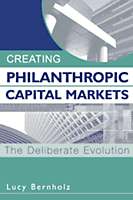Positioning philanthropy
Philanthropy - in its most highly evolved institutional forms - exists at the whim of the public sector. Foundations, donor advised funds, charitable remainder trusts are products created by the tax code. A couple of swift kicks to the tax code and we could see some fairly significant changes in the philanthropic and financial services landscapes. A permanent repeal of the estate tax could "result in a decrease in giving through charitable bequests of between $1.5 to $5 billion, based on 1999 levels." (independentsector.org/programs/gr/estatetax.html). Many of the financial service industries' recent product and service developments for high net worth Americans are based on predictions of their likely charitable giving due to the predicted intergenerational transfer of wealth. Change the laws, change the giving, change the financial products/services offered to manage the giving.
Philanthropy - as we know it - exists as a byproduct of markets and public policy. Why then is it (organized, institutional philantrhopy) generally so reluctant to engage proactively with either business or government?
Bookmark this on Del.icio.us




